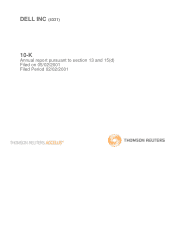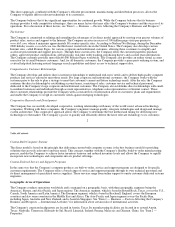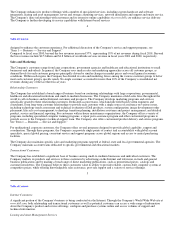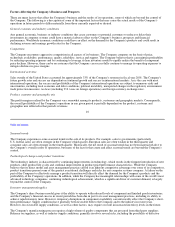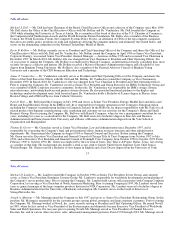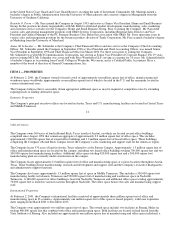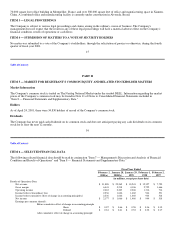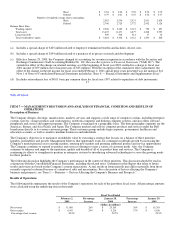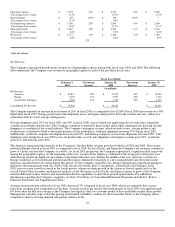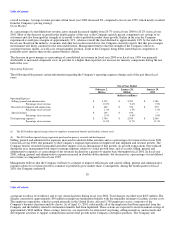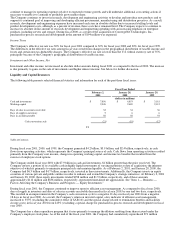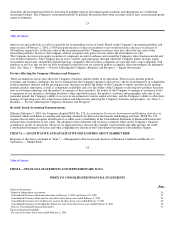Dell 2000 Annual Report Download - page 10
Download and view the complete annual report
Please find page 10 of the 2000 Dell annual report below. You can navigate through the pages in the report by either clicking on the pages listed below, or by using the keyword search tool below to find specific information within the annual report.
Factors Affecting the Company's Business and Prospects
There are many factors that affect the Company's business and the results of its operations, some of which are beyond the control of
the Company. The following is a description of some of the important factors that may cause the actual results of the Company's
operations in future periods to differ materially from those currently expected or desired.
General economic and industry conditions
Any general economic, business or industry conditions that cause customers or potential customers to reduce or delay their
investments in computer systems could have a material adverse effect on the Company's business, prospects and financial
performance. Worldwide economic conditions could have an effect on the demand for the Company's products and could result in
declining revenue and earnings growth rates for the Company.
Competition
The Company encounters aggressive competition in all aspects of its business. The Company competes on the basis of price,
technology availability, performance, quality, reliability, service and support. The Company believes that it can maintain profitability
by reducing operating expenses and by continuing to leverage its lean inventory model to rapidly realize the benefit of component
price declines. However, there can be no assurance that the Company can successfully continue to manage its operating expenses to
mitigate declines in gross margins.
International activities
Sales outside of the United States accounted for approximately 33% of the Company's revenues in fiscal year 2001. The Company's
future growth rates and success are dependent on continued growth and success in international markets. As is the case with most
international operations, the success and profitability of the Company's international operations are subject to numerous risks and
uncertainties, including local economic and labor conditions, political instability, unexpected changes in the regulatory environment,
trade protection measures, tax laws (including U.S. taxes on foreign operations) and foreign currency exchange rates.
Product, customer and geographic mix
The profit margins realized by the Company vary somewhat among its products, customers and geographic markets. Consequently,
the overall profitability of the Company's operations in any given period is partially dependent on the product, customer and
geographic mix reflected in that period's revenues.
10
Table of Contents
Seasonal trends
The Company experiences some seasonal trends in the sale of its products. For example, sales to governments (particularly
U.S. federal sales) are often stronger in the Company's third quarter, European sales are often weaker in the third quarter and
consumer sales are often stronger in the fourth quarter. Historically, the net result of seasonal trends has not been material relative to
the Company's overall results of operations, but many of the factors that create and affect seasonal trends are beyond the Company's
control.
Technological changes and product transitions
The technology industry is characterized by continuing improvements in technology, which results in the frequent introduction of new
products, short product life cycles and continual improvement in product price/performance characteristics. While the Company
believes that its direct model and asset management practices afford it an inherent competitive advantage over some of its competitors,
product transitions present some of the greatest executional challenges and risks for any computer systems company. A failure on the
part of the Company to effectively manage a product transition will directly affect the demand for the Company's products and the
profitability of the Company's operations. In addition, while the Company has meaningful relationships with some of the world's most
advanced technology companies, continuing technological advancement, which is a significant driver of customer demand, is largely
beyond the control of the Company.
Inventory management/supplies
The Company's direct business model gives it the ability to operate with reduced levels of component and finished goods inventories,
and the Company's financial success in recent periods has been due in part to its asset management practices, including its ability to
achieve rapid inventory turns. However, temporary disruptions in component availability can unfavorably affect the Company's short-
term performance. Supply conditions have generally been favorable both to the Company and to the industry in recent years.
However, less favorable supply conditions, as well as other factors, may require or result in increased inventory levels in the future.
The Company's manufacturing process requires a high volume of quality components that are procured from third party suppliers.
Reliance on suppliers, as well as industry supply conditions, generally involves several risks, including the possibility of defective

